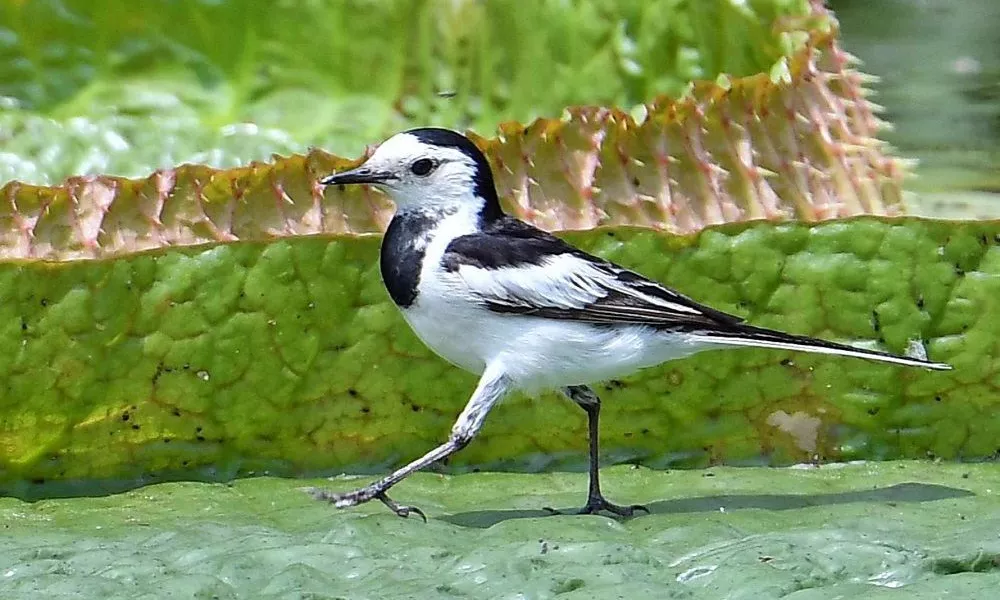The white wagtail (Motacilla alba) is a small passerine bird in the family Motacillidae, which also includes pipits and longclaws. The white wagtail is the national bird of Latvia and has featured on the stamps of several countries.
The White wagtail (Motacilla alba) has a total length of about 18 cm, a wingspan of 31 cm, a weight of 23 grams, and a life span of 10 years. Body feathers are black and white. It inhabits near villages, rivers, creeks, ponds, etc. It can be seen in cultivated land and pastures near water. Often in pairs or in small groups. Feeds on insects. Walk on the ground while foraging, or hunt insects in the air. When flying, it advances in waves, and when it rests, its tail keeps swinging up and down. The breeding season is from March to July. Nests are built on roofs, caves, and rock crevices. The nests are made of grass stems, fine roots, bark, and dead leaves. The nests are cup-shaped. Each clutch lays 4-5 eggs. It is mainly distributed in most parts of Eurasia, the Arab region in northern Africa, and most parts of China.
What does White wagtail look like?
The White wagtail is white on the forehead and face, and black on the back of the head, bolster and nape. Back, shoulders black or gray, flight feathers black. The small coverts on the wings are gray or black, the middle and large coverts are white or the tips are white, forming obvious white wing spots on the wings. The tail is long and narrow, the tail feathers are black, and the outermost two pairs of tail feathers are mainly white. The chin and throat are white or black, the chest is black, and the rest of the lower body is white. Iris dark brown, mouth and tarsus black.
White wagtail habitat
It mainly inhabits the banks of rivers, lakes, reservoirs, ponds and other waters, and also in wetlands such as farmland, wet grasslands, and swamps, and sometimes inhabits settlements and parks near waters.
White wagtail living habit
Often alone in pairs or in small groups of 3-5. During the migration period, large flocks of more than 10 to more than 20 individuals are also seen. It mostly lives on the ground or on rocks, sometimes on small shrubs or trees, and usually lives in grasslands, farmland, barren slopes or roadsides near water or near water, or walks slowly on the ground, or runs and preys . When meeting people, it takes off obliquely, singing while flying. The sound is crisp and loud, and the flying posture is wavy. Sometimes it stands in one place for a long time, and the tail keeps swinging up and down.
What do White wagtails eat?
The white wagtail is an insectivorous bird of open country, often near habitation and water. It mainly feeds on insects, mainly Coleoptera, Diptera, Lepidoptera, Hymenoptera, Orthoptera, etc. Grubs, beetles, rice weevils, caterpillars, locusts, cicadas, katydids, scarabs, ants, bees, walking insects, moths, flies, aphids, maggots, pupae and insect larvae, etc. They also eat other invertebrates such as spiders, and occasionally plant foods such as plant seeds and berries.
Mode of reproduction
The breeding season is from April to July. Usually nest in rock caves, rock wall crevices, riverside ridges, field edge stone crevices, river banks, bushes and grasses near waters such as waters, and nests in house ridges, roof and wall crevices, and even in dead wood. Nests in tree cavities and artificial nest boxes. The nest is cup-shaped, the outer layer is rough and loose, mainly composed of hay stems, hay leaves and grass roots, and the inner layer is tight, mainly woven by bark fibers, hemp, and fine grass roots. The nest is cushioned with animal hair, down feathers, hemp and other soft materials. The size of the nest is 11-16 cm, the inner diameter is 6-11 cm, the depth is 4-5 cm, and the height is 7-8 cm. The nesting is shared by the male and female parent birds. After the nest is built, it starts to lay eggs. Usually 5-6 eggs are laid per nest, but there are also as few as 4 and as many as 7 eggs per nest. Eggs are 19-22mm x 14.5-16mm in size, 2-2.6g in weight, off-white with light brown spots. Incubation is carried out by male and female parents in turn, but females are the main ones, and the incubation period is 12 days. The chicks are late adults, and after hatching, the male and female parents will jointly raise the chicks, and the chicks can leave the nest in about 14 days.
Distribution area of White wagtail
White wagtails are residents in the milder parts of its range such as western Europe and the Mediterranean, but migratory in much of the rest of its range. Northern European breeders winter around the Mediterranean and in tropical and subtropical Africa, and Asiatic birds move to the Middle East, India, and Southeast Asia. Birds from the North American population also winter in tropical Asia.


 Facebook
Facebook  Instagram
Instagram  Youtube
Youtube 